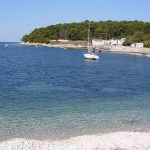An exhibition entitled The Baron Gautsch: The First Victim of World War One in Istria was opened Villa Angiolina in Opatija in spring and will remain open until October 15, 2016. The organisers of the exhibition are the History and Maritime Museum of Istria from Pula and the Croatian Museum of Tourism. The exhibition has first been shown at the Maritime Museum of Pula in 2014.
The fatal story of the Baron Gautsch steamship is one of the most interesting ones in the naval history of the Adriatic and the wreck of the ship is one of Istria’s biggest diving attractions. The wreck of the Baron Gautsch is one of the most attractive diving sites of the Adriatic. A German diving magazine listed the wreck among the 10 most attractive ones in Europe, while the UK Red Sea Wreck Academy listed it among the 50 most attractive diving sites in the world. Today, the wreck is protected by the Croatian Ministry of Culture.
The story of the Baron Gautsch is told in short below. The exhibition is authored by custodian Katarina Pocedić from the History and Maritime Museum of Istria in Pula. If you decide to visit the exhibition, also buy the catalogue with excellent translations into German (cough, cough), English and Italian languages.
The Baron Gautsch was a modern passenger steamship of the Austro-Hungarian fleet. It was built in 1908 at the Gourlay Brothers Company shipyard in Dundee in the UK and played an important role in connecting the southern Adriatic with the rest of Europe. The ship sailed on the Trieste-Dubrovnik-Kotor route, and its capacity was 300 passengers.
At the beginning of WW I, ships started evacuating civilians and transporting soldiers to Italy. During one such voyage, on 13 August 1914 at 14:45 at a distance of six miles from Rovinj, between the Brijuni Islands and the Sveti Ivan lighthouse, the Baron Gautsch hit an Austrian sea mine and sank within seven minutes. 190 passengers survived the tragedy, but the exact number of victims was never determined, as soldiers and children were not listed. According to the available information, the ship had twice as many passengers as it should have had.

Captain Paul Winter spent the crucial time of the voyage with a mystery woman in a ship’s cabin; First Officer Josef Luppis was having lunch with first class passengers, and Second Officer Giuseppe Tenze was navigating the ship too close to the coast, although he had been warned that they should keep a distance of 15 miles from it. Overloaded with passengers that were escaping war-affected areas, the ship departed northbound from Kotor on 12 August and entered the port of Lošinj, where many mothers with children who were returning from their holidays embarked. Because there were too many passengers on board, the ship did not sail into Pula. Soon after, it entered a minefield that had been set by the Austro-Hungarian Navy to protect its main naval port.

The wreck was first discovered by the Italian diver Giacomo Stocca in 1951. The marine salvage company Brodospas officially located its position in 1958, and in 1975 it was first filmed for Mario Saletto’s Secrets of the Adriatic TV series. As a significant dive site, the wreck was put under protection in 1995. During the systematic protection and research work, which had begun one year earlier, 78 items were taken from the wreck, restored and housed in Pula Museum. These items, together with archive materials, photographs, documents and items from private collections and other institutions, will be displayed in this exhibition.









